Elder Perry: Mormon Pavilion at 1964 World's Fair Had Impact
Contributed By R. Scott Lloyd, Church News staff writer
In this video, Elder L. Tom Perry recalls how the Mormon Pavilion at the New York World's Fair in 1964 affected missionary work by increasing the understanding and awareness of the Church in that day.
Article Highlights
- This year, 2014, is the 50th anniversary of the 1964 New York World's Fair.
- The Mormon Pavilion increased understanding and awareness of the Church in that day.
- Today's Meet the Mormons movie serves a similar purpose as the movie Man’s Search for Happiness, which was produced for the fair.
“We watched the miracle of people being introduced to the Church. A large number of converts came as a follow-up to that experience.” —Elder L. Tom Perry of the Quorum of the Twelve
Related Links
Its impact can be hard to imagine in the Internet age, but 50 years ago, when the New York World’s Fair of 1964–65 was staged, it was a chance for many people to experience an array of world culture and glimpse the technological dazzle of the future.
For The Church of Jesus Christ of Latter-day Saints, it represented groundbreaking methods of taking the gospel message to multitudes.
The Mormon Pavilion at the fair has left a lingering legacy immediately observable in the art, dioramas, and multimedia technology of today’s visitors’ centers.
“Experience obtained from this exposition formed the philosophy and methodology of Church visitors’ centers,” wrote Brent L. Top, dean of religious education at Brigham Young University, in a soon-to-be-published article. “Indeed the huge leap forward initiated by the Mormon Pavilion must be considered a seminal event in the evolution of the Church’s use of media in spreading the gospel message to the world. From that time to the present day, the Church’s outreach through its use of technology and media has increased steadily and exponentially.”
The Christus statue, copied from Bertel Thorvaldsen’s sculpture at a Lutheran church in Copenhagen, Denmark, has become one of the most recognizable of LDS symbols. A Church-commissioned replica was first displayed in the Mormon Pavilion at the New York World’s Fair.
The film Man’s Search for Happiness, for many years a staple of missionary work, was produced expressly for exhibition at the Mormon Pavilion.
In his article, Brother Top notes that the newly announced feature-length motion picture to be shown in theaters and visitors’ centers, Meet the Mormons, is on a path “that is traceable to Man’s Search for Happiness and the Mormon effort at the 1964–65 New York World’s Fair.”
By 1964, Church participation at international exhibitions had been going on for a long time, beginning with the World’s Columbian Exposition in Chicago, Illinois, in 1893, where the Mormon Tabernacle Choir won second place in the choral competition. Later, the Church would sponsor booths at international expositions in Dresden, Germany, in 1930; Chicago in 1933–34; San Diego, California, in 1935–36; and San Francisco, California, in 1939–40.
But nothing even approaching the scale of the Mormon Pavilion in New York had ever been attempted.
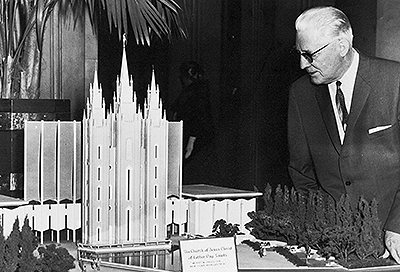
President Hugh B. Brown of the First Presidency studies a model of the Mormon Pavilion for the New York World's Fair, at the Waldorf-Astonia Hotel. Photo courtesy of Deseret News archives.
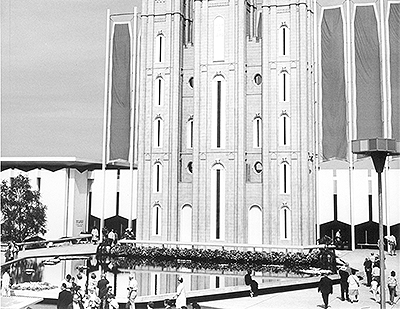
The Mormon Pavilion, whose façade replicated the east spires of the Salt Lake Temple, was one of the attractions at the 1964 New York World's Fair. Photo courtesy of Deseret News archives.
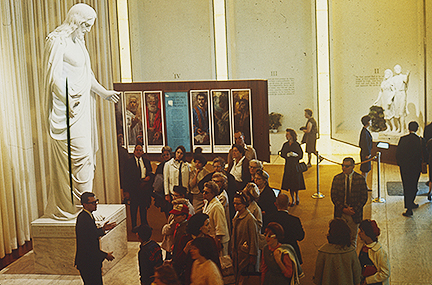
Visitors gather near a replica of the Christus statue in the Mormon Pavilion at the New York World's Fair, which was held in 1964. Photo courtesy of Deseret News archives.

Inside the Mormon Pavilion at the New York World's Fair, a missionary guide speaks to visitors about Adam and Eve and the Garden of Eden. Photo courtesy of Deseret News archives.
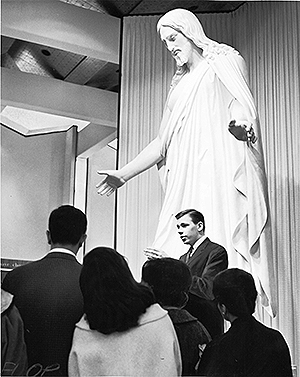
A replica of the Christus statue was a major feature of the Mormon Pavilion at the New York World's Fair, which opened in 1964. Photo courtesy of Deseret News archives.
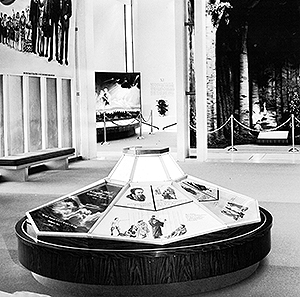
The Mormon Pavilion at the 1964 World's Fair featured exhibits about the Church and its history and doctrines. Photo courtesy of Deseret News archives.
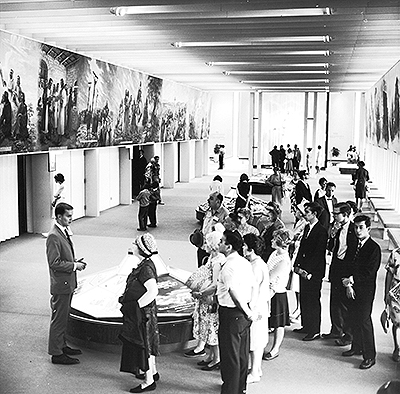
Visitors view exhibits and listen to presentations in the Mormon Pavilion at the New York World's Fair in 1964. Photo courtesy of Deseret News archives.
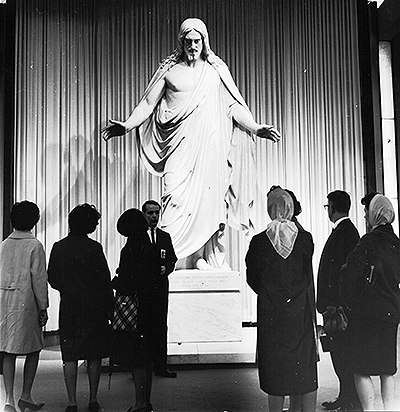
A replica of the Christus statue was a major feature of the Mormon Pavilion at the New York World's Fair, which opened in 1964. Photo courtesy of Deseret News archives.
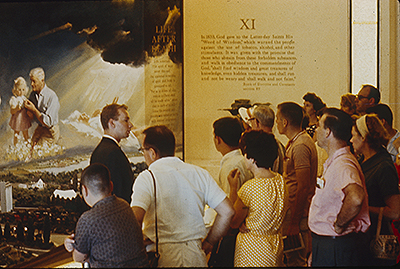
A missionary guide speaks to visitors to the Mormon Pavilion at the New York World's Fair. Photo courtesy of Deseret News archives.
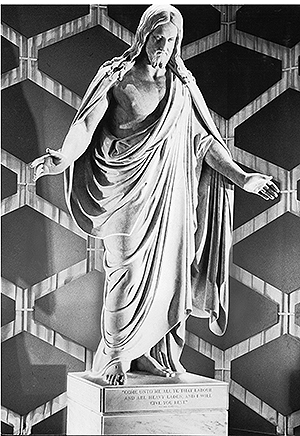
A replica of the Christus statue was a major feature of the Mormon Pavilion at the New York World's Fair, which opened in 1964. Photo courtesy of Deseret News archives.
The idea came initially from Stanley McAllister, president of the New York Stake. In 1960, he approached Church leaders with his idea that a pavilion be constructed for the planned fair in New York.
Initially, they balked at the estimated $3 million cost. But it was known that other religious groups planned participation at the fair, such as a Catholic pavilion with priceless art masterpieces shipped in from the Vatican, including Michelangelo’s famous statue Pieta.
By 1962, Church leaders had warmed to the idea. But choice sites for pavilions at the fair were going fast. After an urgent call from President McAllister, Church President David O. McKay responded within a day, telling him the First Presidency had approved the proposal.
The first choice for a site was gone, but a personal friend of President McAllister interceded with fair president Robert Moses, and a choice site was secured near the fair’s front entrance, close to a major subway line and neighboring Shea Stadium.
The spot was located next to the World of Food Pavilion. At the previous world’s fair in Seattle, Washington, the food pavilion had been perceived as an eyesore.
As it happened, the funding for the food pavilion did not materialize and the owners had to back out. That left a vacant lot next to the Mormon Pavilion. Church officials seized the opportunity to work with fair officials to plant a garden on the vacant lot. “Irvin T. Nelson, landscape and pavilion grounds architect for the Church, turned the lot into a place of peace and beauty that contributed greatly to the success of the Mormon Pavilion,” Brother Top wrote in an October 1989 Ensign magazine article about the legacy of the pavilion. “The landscaping won praise from the president of the fair and from workers there, as well as a national award for Brother Nelson from the American Association of Nurserymen.”
In 1964, Elder L. Tom Perry, now of the Quorum of the Twelve Apostles, was a 42-year-old high councilor in the New York Stake.
“My high council assignment was the stake mission, so that naturally blended into my being called to be on the Church committee for the world’s fair,” Elder Perry recalled in an interview with the Church News. “It was one of the most delightful assignments I’ve had in my life.”
Of the construction of the pavilion, he recounted, “I’ll never forget the day that we went out to drive piles into the marshy soil in that part of New York. The pile driver hit it twice, and the pile was literally swallowed up. So we knew we had a challenge. But the pavilion turned out to be beautiful.”
Indeed, the exterior was a commanding sight, its façade replicating the east spires of the Salt Lake Temple. That was suggested by Elder Richard L. Evans of the Quorum of the Twelve Apostles and his brother, advertising executive David W. Evans, and was inspired by the memory of growing up in the avenues area of Salt Lake City and seeing the temple spires as they walked down the hill.
Elder Bernard P. Brockbank, who held the General Authority position of Assistant to the Quorum of the Twelve, was assigned to supervise the pavilion, Elder Perry remembered. “He moved to New York and had an apartment very near the world’s fair, and I was one of his assistants as the fair developed. I had two nights a week that I was responsible for supervising the pavilion, so we were at the fair a great deal.
“And it was a nice assignment, because they gave us a family pass, and we could go to the fair anytime we wanted. My family loved the fair. And that pavilion turned out to be a great inspiration to all who attended.”
Depicted in art and dioramas was Church doctrine pertaining to Christ organizing the Church and calling His Apostles, the Apostasy and latter-day Restoration, the events pertaining to the organization of the Church, the martyrdom of the Prophet Joseph Smith, the westward trek of the Mormon pioneers, and the commission to take the gospel to all the world.
Full-time missionaries were engaged as tour guides, and the Book of Mormon was featured prominently.
“I think I sold more copies than any of the elders, because I would offer to buy a copy for a visitor if the visitor would take it and read it and report back to me that he had read it,“ Elder Perry said. ”I had the 50 cents right there, but it was such a small amount, they’d pay the 50 cents and take it and go.”
Among the missionaries assigned to work at the fair was Richard Eyre, who today, with his wife, Linda, is a Deseret News columnist and author of best-selling books on family relations.
“Talk about a life change!” he recalled. “One day I was tracting in New Jersey and the next day I was at the world’s fair with people coming to me in droves.”
He remembered the location next to the Catholic pavilion where the Pieta was being displayed, depicting Mary holding the slain Christ.
“I remember thinking how beautiful and lifelike it was. And candidly, the Christus is great because it is the resurrected Christ, but artistically, it can’t hold a candle to Pieta.
“But one night, I was closing up the pavilion, and I thought we had everyone out. I was about to lock the door, and I noticed a man standing at the other end of the pavilion in front of the Christus statue.
“I hated to disturb him, but I put my hand on his shoulder from the back. He turned around, and it was then I realized he was a Catholic priest.”
Elder Eyre told him it was time to close the pavilion, and the tearful priest said, “That’s all right. I was just worshipping Christ.”
John Garbett, who today is a product manager for media with Church Welfare Services, was 10 years old when the fair opened. His family lived in nearby Chappaqua. His father, William, was on the high council with Elder Perry and worked closely with him at the Mormon Pavilion.
“You think that you’re a small part of a fairly small organization that doesn’t have much of an international reach,” he said of his youth. “And then you go to the world’s fair and you see our pavilion next to the Catholic pavilion and with all the other corporate sponsors. It totally changed my mind forever about how I viewed our faith and myself as a member of our faith.”
He added, “The fun thing about the fair, for a 10-year-old kid, was this: You know the ride at Disneyland called It’s a Small World? That was built for the fair. Now, every time I go to Disneyland and take that ride, to me it’s going back to the world’s fair in 1964.”
He recalls the performance at the fair by the Mormon Tabernacle Choir and by a regional choir of Relief Society women who, like similar Relief Society choirs around the Church, went by the name of “The Singing Mothers.”
But, growing emotional even now, after 50 years, Brother Garbett said the thing he remembers best is seeing his father come home after working at the pavilion and telling of people he had met and talked to, who had gone through the exhibits and had been touched.
“They had learned a truth or an idea they had never thought about: that we have a loving Heavenly Father who has a plan for us. I think the decision to focus on the plan of salvation was totally inspired.”
Indeed, the theme of the pavilion was “Man’s Search for Happiness,” the title of the movie produced expressly for it, with narration by Elder Richard L. Evans, longtime announcer for the Mormon Tabernacle Choir’s weekly broadcasts.
“Sometimes in your search for happiness,” the film begins, “you ponder the meaning of your life. You sift your memory for beginnings. You send your mind ahead for directions. But all you really know is now, and you are lost in the present.”
With images of a family experiencing birth, joy in relationships, the death of a grandfather, and his emergence into the spirit world to await the resurrection, the 15-minute film depicts doctrines of the premortal existence, mortality, and man’s eternal destiny.
“The other thing that stands out for me is the Christus,” Brother Garbett said. “I remember seeing it again and again. It countered the notion that our faith is not Christian. When people came into the pavilion, they would know this is who we worship.”
Some think the copy of the sculpture on Temple Square in Salt Lake City was commissioned originally for the fair.
Actually, the first copy was already in the Church’s possession, in a crate at what would become the South Visitors’ Center on Temple Square, which was then still under construction.
According to a brief history written by Matthew O. Richardson, then professor of Church history and doctrine at BYU and now BYU vice president of advancement, the sculpture was a gift from President Stephen L Richards to the Church.
President Richards, a counselor in the First Presidency, had seen it years earlier in Denmark and had seen a copy of it at the Forest Lawn Cemetery in California. He commissioned the work but did not live to see it placed on display.
When the time came, it was determined that it would be less expensive to commission a new copy of the statue and have it shipped from Italy than it would be to remove the existing one from the unfinished visitors’ center in Salt Lake City.
After the world’s fair closed in 1965, the Mormon Pavilion Christus was shipped to the Los Angeles Temple Visitors’ Center, where it is on display today. Other copies have since been made for display at visitors’ centers in Laie, Hawaii; Mesa, Arizona; Mexico City; Washington, D.C.; Oakland, California; St. George, Utah; Nauvoo, Illinois; and Palmyra, New York. A smaller, traveling statue is displayed in connection with new temple open houses, most recently in Ogden, Utah.
Perhaps the most important legacy of the pavilion is the convert baptisms that came of it.
“We watched the miracle of people being introduced to the Church,” Elder Perry said. “A large number of converts came as a follow-up to that experience. I was asked, along with Ken Beesley, to be the high councilor responsible for organizing the Rego Park Branch. It was a brand-new branch created as a result of world’s fair converts.”
Brother Top wrote, “David W. Evans remembered that the year previous to the fair there were only six converts baptisms in [the New York, New Jersey, and Cumorah Stakes] but a thousand baptisms in each of the two years the fair was open and ‘in the succeeding several years, there were six to eight hundred per year.’”
Brother Top concluded, “The Church’s innovative involvement in the New York World’s Fair can be inarguably characterized as seminal for the Church in the New York City area in the 20th century. However, its influence reached beyond the borders of New York, and its legacy continues to be felt into the 21st century and beyond.”
